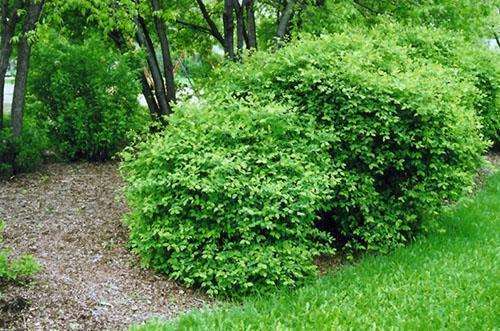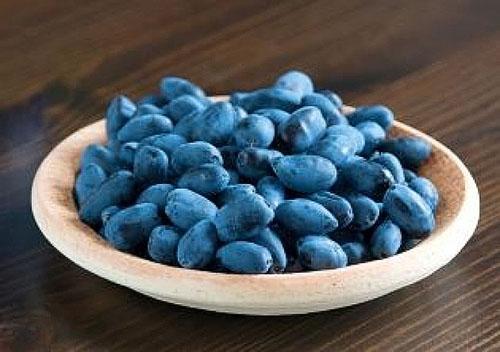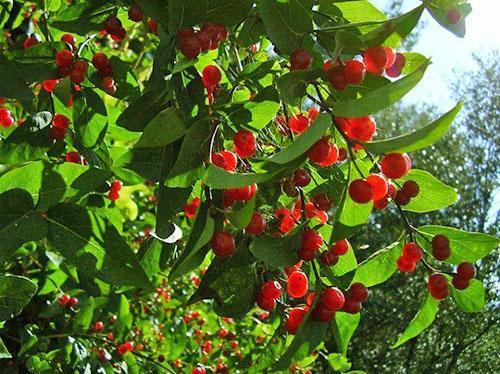Edible honeysuckle fruits: useful properties and contraindications
 Homeland honeysuckle edible are the northwestern territories of Russia. This plant is a shrub that grows up to 2 meters in height. Many types of honeysuckle have valuable decorative qualities, therefore, they are common not only in the wild, they have become frequent guests of personal plots, parks and front gardens.
Homeland honeysuckle edible are the northwestern territories of Russia. This plant is a shrub that grows up to 2 meters in height. Many types of honeysuckle have valuable decorative qualities, therefore, they are common not only in the wild, they have become frequent guests of personal plots, parks and front gardens.
This plant is used not only in landscaping. The peoples that inhabit its natural habitat have long used honeysuckle to treat various diseases. We invite you to learn more about the beneficial properties edible honeysuckle and contraindications to its use.
Related article: gooseberry - benefits and harms to the body!
The use of honeysuckle fruits in traditional medicine

Of the more than 200 species of wild and cultivated honeysuckle, only a few are edible. Such species can be recognized by the color of the fruit - from blue to blue-black. The berries of poisonous species are usually colored bright red and orange.

Berry composition
Modern science explains the beneficial properties of honeysuckle fruits by their unique chemical composition. In addition to sugars and organic acids, they contain a large amount of vitamins:
- C - helping to strengthen the immune system and participating in most metabolic processes in the body;
- A - responsible for the condition of the organs of vision, skin, hair and nails;
- B1 - promoting the strengthening and restoration of nerve cells;
- B2 - responsible for the health of the whole organism.
 The mineral composition of the berries is also varied. They contain sodium, potassium, magnesium, barium, iodine, aluminum, copper, manganese and strontium, which are important for the normal functioning of the body. The beneficial properties of honeysuckle berries are also due to the high content of pectins, anthocyanins and tannins. At the same time, the calorie content of the fruit is only 30-32 kcal.
The mineral composition of the berries is also varied. They contain sodium, potassium, magnesium, barium, iodine, aluminum, copper, manganese and strontium, which are important for the normal functioning of the body. The beneficial properties of honeysuckle berries are also due to the high content of pectins, anthocyanins and tannins. At the same time, the calorie content of the fruit is only 30-32 kcal.
Application of berries
 Traditional medicine recommends combating many diseases with the help of delicious honeysuckle fruits. First of all - with vitamin deficiency. Honeysuckle is an early crop and, depending on the variety, bears fruit in June-July. In fact, these are the first berries rich in vitamins and microelements, which help to overcome the consequences of the difficult autumn-winter period.
Traditional medicine recommends combating many diseases with the help of delicious honeysuckle fruits. First of all - with vitamin deficiency. Honeysuckle is an early crop and, depending on the variety, bears fruit in June-July. In fact, these are the first berries rich in vitamins and microelements, which help to overcome the consequences of the difficult autumn-winter period.
It is difficult to overestimate the benefits of honeysuckle in the treatment of hypertension and vascular diseases. This plant is a close relative of viburnum and, like it, helps to lower blood pressure. But, unlike viburnum, honeysuckle berries act more slowly, and the effect of their use lasts longer. Also, the fruits of this plant help to relieve headaches, which often suffer from hypertension, and vitamins A and B help to strengthen the walls of blood vessels.
Honeysuckle is an excellent antiseptic, so it can be used for various viral and bacterial infections: sore throats, flu, purulent wounds, conjunctivitis, infections of the digestive, respiratory and urinary organs. In addition to destroying pathogens, it will strengthen the immune system and have an antipyretic effect.
In folk medicine, the fruits of honeysuckle are also used to treat diseases of the female genital area, constipation, metabolic disorders and many other diseases.
How to use honeysuckle berries?
 To achieve a lasting healing effect, honeysuckle fruits should be taken daily from the very beginning of fruiting, 100 mg (approximately half a glass) per day. In addition, the beneficial properties of honeysuckle are practically not lost during freezing, drying and heat treatment, so throughout the year you can pamper yourself with delicious jam, compotes, juices and fruit drinks.
To achieve a lasting healing effect, honeysuckle fruits should be taken daily from the very beginning of fruiting, 100 mg (approximately half a glass) per day. In addition, the beneficial properties of honeysuckle are practically not lost during freezing, drying and heat treatment, so throughout the year you can pamper yourself with delicious jam, compotes, juices and fruit drinks.
Honeysuckle berries must not be re-frozen. Thawed and then re-frozen fruits can cause digestive upset. The same effect is obtained by the joint consumption of honeysuckle and gooseberries.
Contraindications
Despite the beneficial properties of honeysuckle fruits, there are also contraindications to its use:
- the effect of this plant has not been sufficiently studied during pregnancy and lactation, therefore, during these periods it is better to avoid its use;
- honeysuckle fruits often cause allergies;
- when treating children, the dosage should be carefully observed, since excessive consumption can cause them to develop a rash (it is better to start with several berries, gradually increasing their number);
- do not recommend using honeysuckle for gastritis, ulcers of the digestive system and during an exacerbation of cystitis.